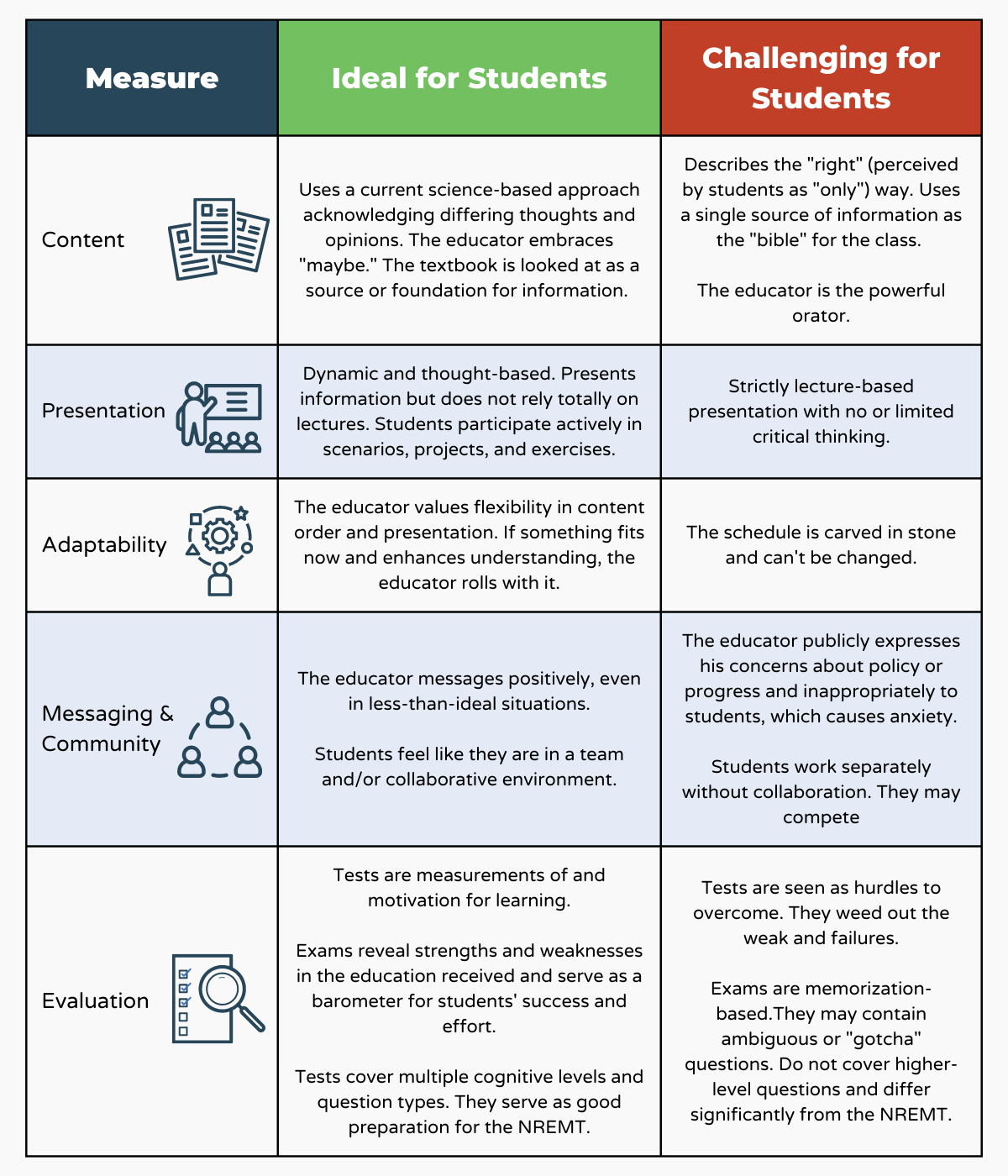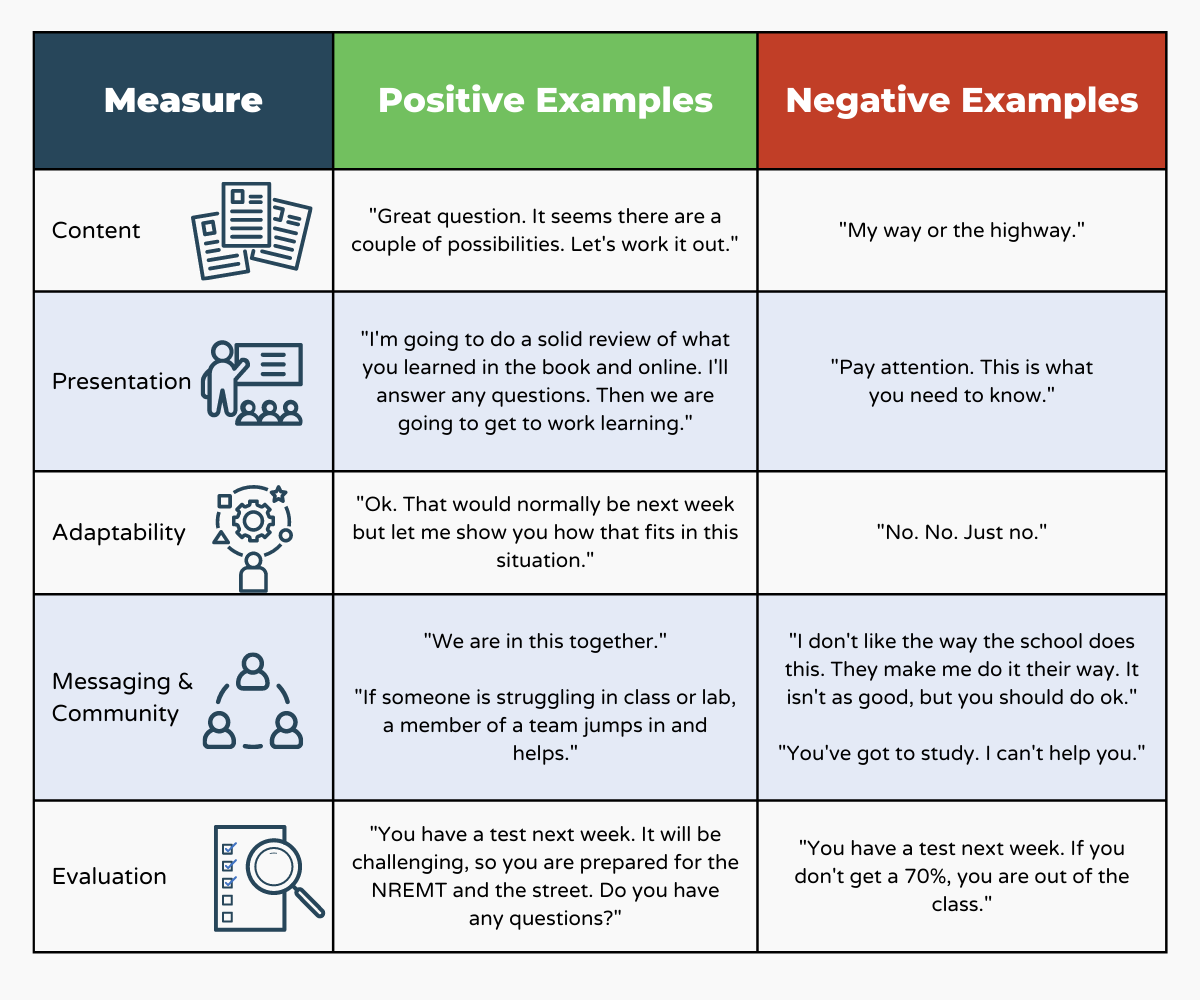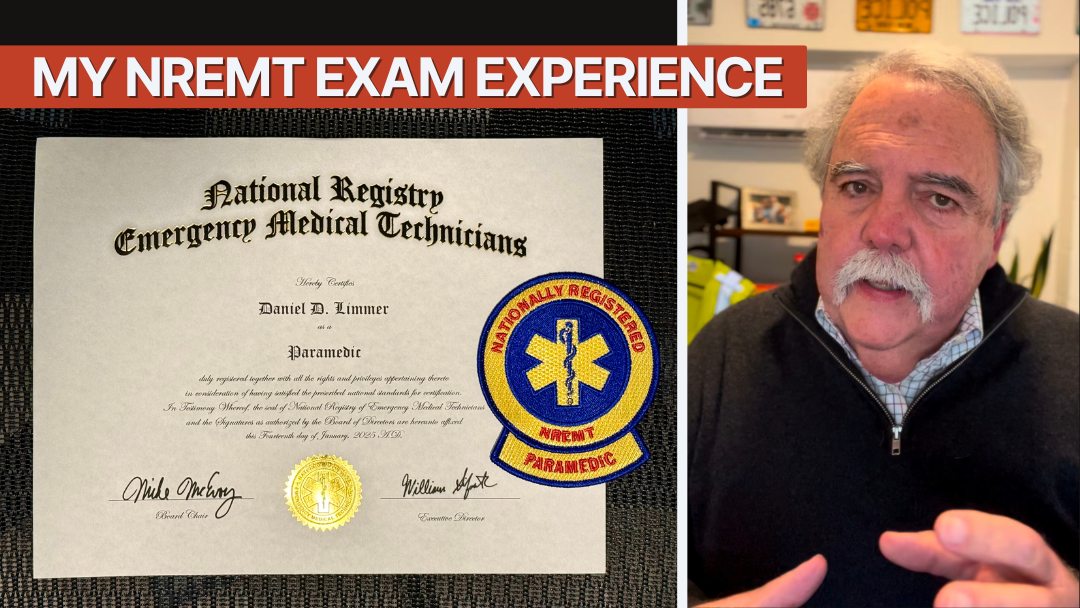5 Measures of Educator Success

by Limmer Education
Our articles are read by an automated voice. We offer the option to listen to our articles as soon as they are published to enhance accessibility. Issues? Please let us know using the contact form.
Part 2 of 2.
What are the true measures of success for educators? Our prior post looked at student success. It is time to focus on educators.
While some may believe education is merely a combination of content and presentation, there are other factors that have a powerful impact on the success of an educator. Much like we must teach our classes the cognitive, psychomotor, and affective domains, we must consider multiple facets of our interactions with students. Content and delivery don’t consider topics important to students like fairness, getting along, comfort, safety, etc.
These measures must be done within your style and level of comfort. There are many ways to achieve positive results.
As you read this, think about where you believe you succeed or need work, and perhaps more importantly, where your students think you may need to put in additional effort.
The Five Measures of Educator Success
Here are the five measures:
Content – It is important for an educator to be aware of the content required in the scope being taught. Multiple sources must be considered, including the National EMS Education Standards, the NASEMSO Model Practice Guidelines, state variations in skills, and the never-ending quest to cover what we believe will be tested on the NREMT exam. Targets that move and vary are the most difficult.
Presentation – More than standing in front of the classroom, presentation of the content is one of the most significant decisions an educator can make. While flipped, active, and dynamic classrooms have been discussed endlessly, presentation combines personal preference and style, experience, technique, and strategy. The sweet spot is when this combination of factors combines for the student's benefit.
Adaptability – Adaptability in the classroom means you can sense a need for change in your presentation or content, and you can make that change on the fly. If a topic is traditionally taught later in your class but presenting it now would help make things relevant, can you teach "out of order?" Can you alter your schedule if a class needs more or less time to master a topic? Adaptability is a mindset as much as or more than a skill.
Messaging/Community – How does your classroom feel to your students? How have you constructed your learning environment? A classroom (in person or online) is ultimately a community. Are your students welcomed, respected (by you and fellow students), and given a safe place to learn? Are questions welcomed and opportunities provided for additional help when necessary? Is there structure? Are your deadlines clear and enforced consistently? Do your students know where they stand? These are all critical elements in the messaging/community category.
Evaluation – Yes, evaluation is testing. Testing determines whether a student passes or fails a class. But it is so much more than that. Does your evaluation tell you what students don’t know? Does your evaluation only occur in structured examinations? Do you evaluate frequently? Do you informally quiz students at the beginning and end of classes?
Comprehensive exams cause students to study. Easy exams allow students to glide and not master important concepts. Do your exams require more than memorization to prepare students for practice and the NREMT?
Below are two tables. The first shows some examples of ideal and less-than-ideal measures.
The second table is similar, but it shows more specific examples of how these positive and negative measures might be expressed in the classroom. Do any of these sayings sound familiar?
Every Measure Matters
While preparing this article, we tried to decide which of these five things was more important or determine whether the failure of a specific element would be most detrimental to an educator and their class. While content and presentation rise to the top of the list, experienced educators know that poor messaging and the inability to adapt to classroom challenges can also create toxicity and failure (or perhaps more so) than content and delivery.
Which of these intertwined classroom concepts do you excel at? Which ones would you like to improve? How will you do that? We’d love to hear your thoughts.
Related articles

Limmer Education
Comments
Leave a commentI like to think of presentations like I teach history taking in patient assessment; follow the line of questioning. It’s ok to not have a script. Some of the best information is gathered when they don’t have to think their way through a check off sheet. I feel our presentations should be just as fluid. Student’s questions often lead to a review of something we’ve already covered, or open up an opportunity to move ahead to a topic that hasn’t been discussed yet. It’s safe to say that no 2 lectures are the same, even when I’ve taught that subject a million times. There’s always something to add or even research when a student asks a question that I’ve never thought of or encountered before. I do believe a great instructor can adapt to any class. I also enjoy the diversity in the classroom and encourage discussions that they feel comfortable shedding some light on. It helps them feel that they are contributing in a beneficial way for when other students will be faced with certain challenges in the field. Their expertise at that point is much better than what I can offer. Of course I always make sure that comments are appropriate and beneficial to the discussion. I also agree 100% that students have to be challenged. If exam or quiz questions are too easy, it doesn’t challenge them and force them to study. Often times I will use exam questions as a way to review material as well as understanding what test/exam questions are looking for. Self evaluation as an instructor is important too, recognize areas we could improve on and continue to stay current with learning theories and how to use them to benefit the student’s educational journey.





